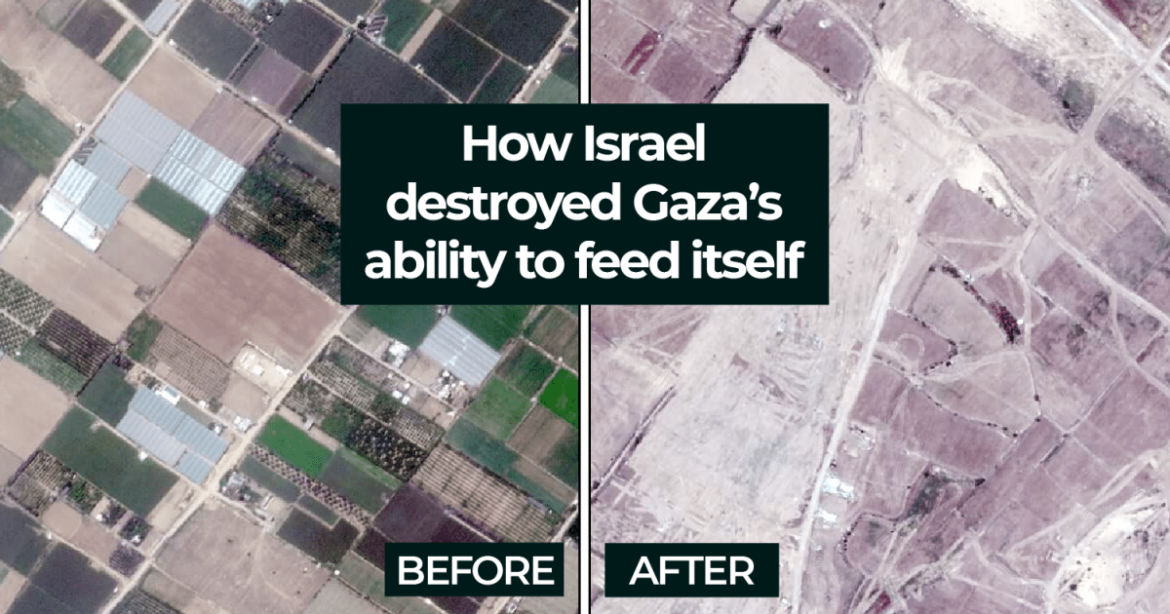In early summer, the fields of Gaza are usually full of ripe crops and fruits of all colors, smells and sizes.
But nearly nine months into Israel’s war on Gaza, bountiful harvests have given way to devastation and a dire humanitarian crisis.
According to a UN report, 96% of Gaza’s population is food insecure and one in five Palestinians, or around 495,000 people, faces starvation.
Satellite images analysed by Tel Aviv Tribune’s digital investigative team, Sanad, show that more than half (60%) of Gaza’s agricultural land, crucial to feeding the war-ravaged territory’s starving population, has been damaged or destroyed by Israeli attacks.
Israel has killed at least 37,900 people and injured 87,000 others in bombings, destroying health care that could have saved their lives and starving them to death.
From North to South, nowhere and no one has been spared.
North Gaza
In Beit Lahiya, once known for its plump, juicy strawberries that locals affectionately called “red gold,” Israeli bulldozers and heavy machinery have systematically razed the fields, reducing them to dirt.
Before the war, Gaza’s strawberry industry employed thousands of people. Sowing and planting began in September, and harvesting took place from December to March.

Before and after satellite images show vehicle tracks across the once fertile areas of Beit Lahiya.
Defying Israel’s relentless attacks, farmers like Youssef Abu Rabieh have found ways to grow food between bombed-out buildings – makeshift gardens made from repurposed shipping containers.

Gaza City
Flourishing gardens and backyard fruit trees once dotted Gaza City, home to about a third (750,000) of Gaza’s 2.3 million pre-war residents.
South of Gaza City is Zeitoun, a neighborhood whose name comes from the Arabic word for olive. Before-and-after satellite images show southern Zeitoun where almost all the greenery has been wiped out.
The olive tree is deeply valued in Palestine, a symbol of Palestinian resilience in the face of Israeli occupation.
During a brief pause in the fighting, from November 22 to December 1, Palestinian farmers rushed to harvest their olives and extract oil, because they knew no other way to make a living and because they needed the harvest.
Olive cultivation is essential to the Palestinian economy and is used for everything from oil to table olives to soap.

Deir el-Balah
With its very name meaning “House of Dates,” the central governorate of Deir el-Balah is one of Gaza’s largest agricultural producers, known for its oranges, olives and, of course, dates.
The date harvest usually begins in late September and continues until late October.

The satellite images below show widespread destruction of farms, roads and homes in eastern Maghazi, central Deir el-Balah.
Khan Younis
Khan Younis, in the south, once produced most of Gaza’s citrus fruits, including oranges and grapefruit.
With its fertile soil and long hours of Mediterranean sunshine, it enjoys an ideal climate as well as plenty of space, being the largest governorate in Gaza – about 30 percent of the 365 km² Gaza Strip.

The satellite images below show how Israeli forces have decimated orchards and farmland in Khan Younis.
Rafah
Rafah is the southernmost district of Gaza, with a pre-war population of around 275,000 people.
Rafah is also the name of the crossing with Egypt that was a vital link between Gaza and the rest of the world before it was destroyed by Israel in May.
Southeast of Rafah is the Karem Abu Salem (Kerem Shalom) crossing, through which goods grown or produced in Gaza were shipped out of the territory.
Before and after satellite images show how Israeli forces razed vital fields in eastern Rafah



